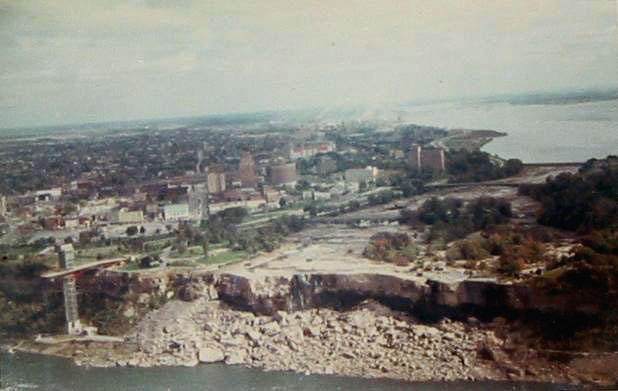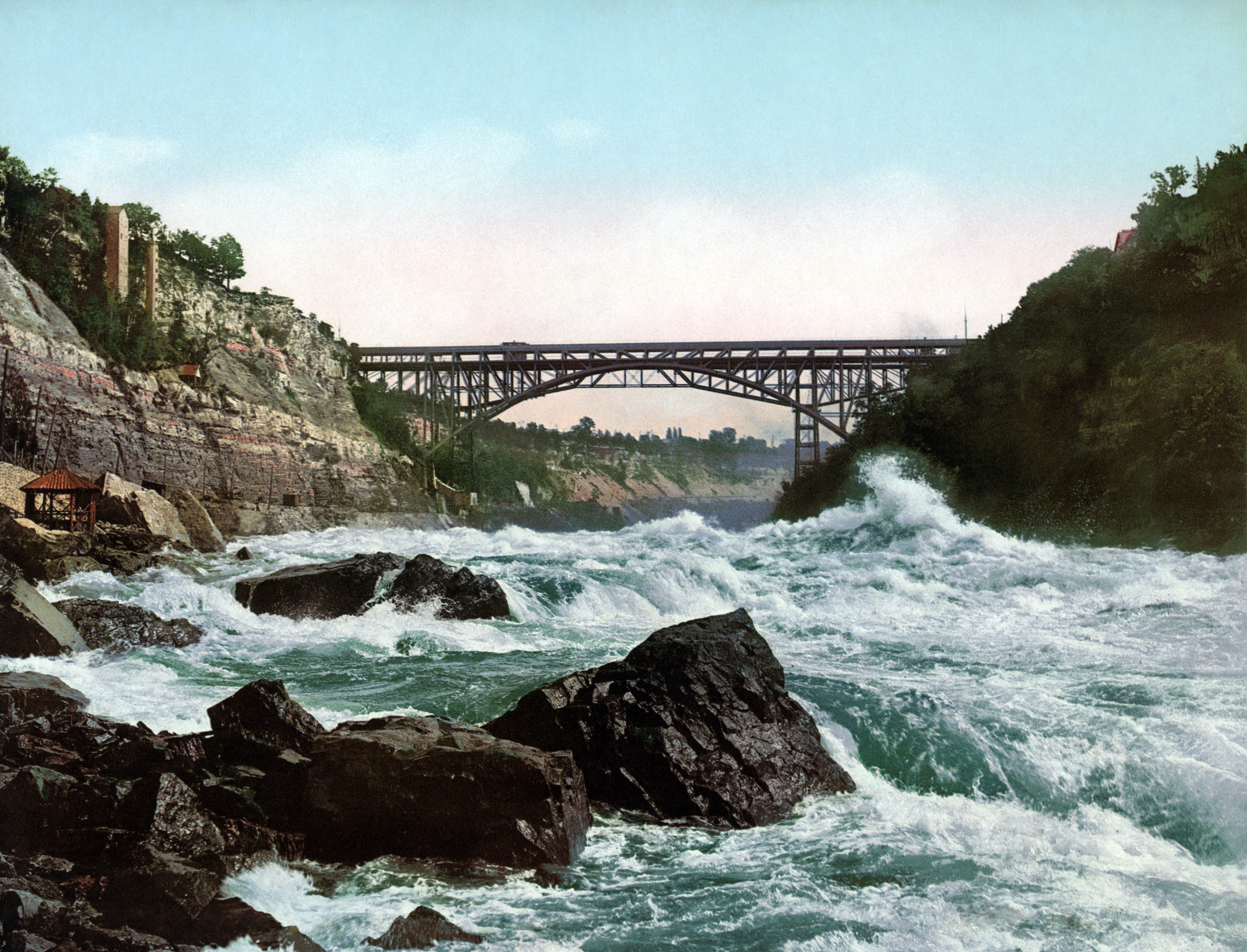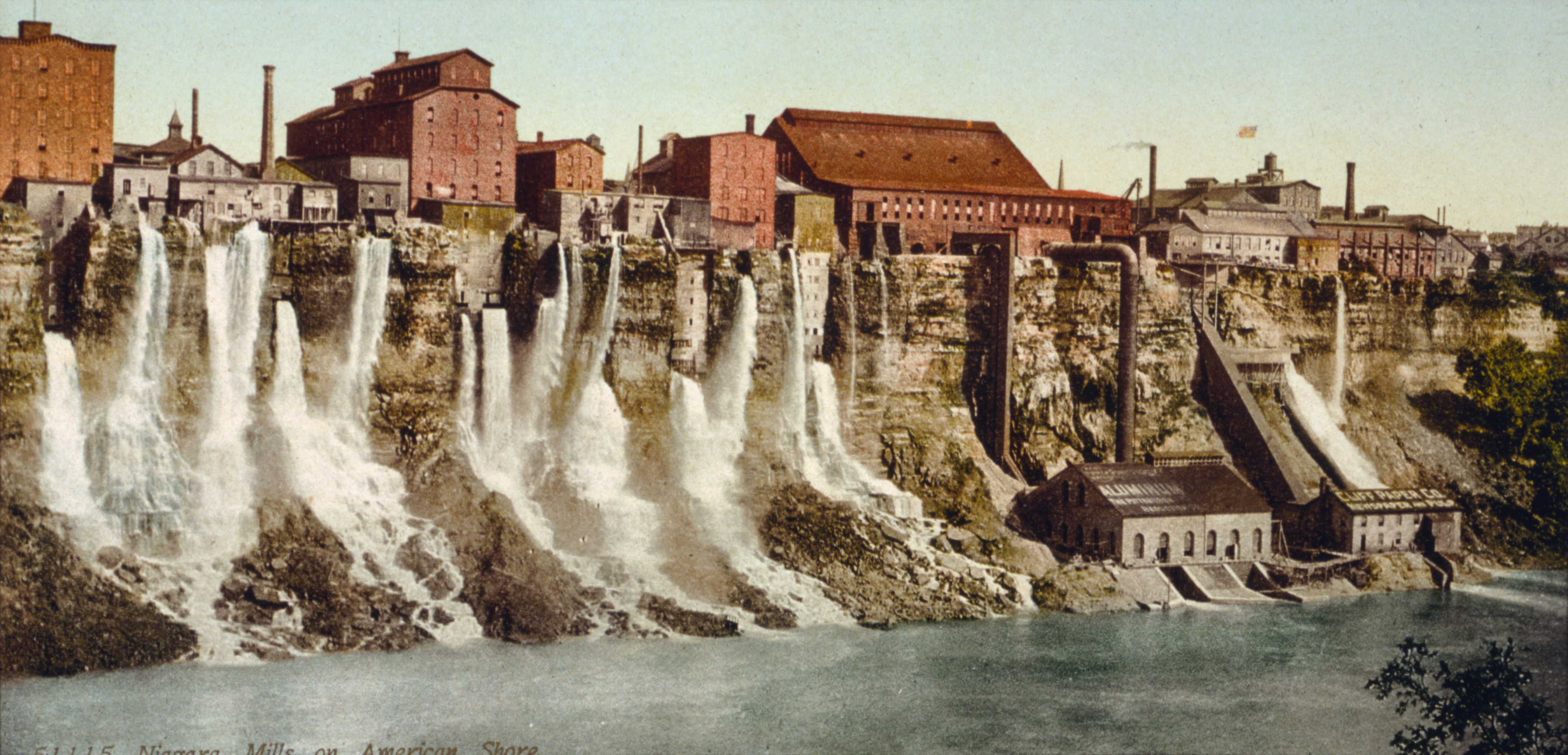|
Jacob F. Schoellkopf
Jacob Friedrich Schoellkopf (November 15, 1819 – September 15, 1899) was a pioneer in harnessing the hydroelectric power of Niagara Falls. Early life Jacob F. Schoellkopf was born on November 15, 1819 in Kirchheim Unter Teck, a small town in the Kingdom of Württemberg. He was the son of Gottlieb Schoellkopf and Christina Maier. He was educated in the town schools and at the age of 14 began learning about tanneries with his father, a large leather manufacturer, who had learned the trade from his father. Career After completing five years of apprenticeship, he became clerk at a mercantile house in Strassberg where he worked for two years. In 1841, he decided to leave Germany and try his fortune in the United States. He landed in New York City at 22 years old in December 1841, and was "totally unacquainted with the English language." Tannery He started working in New York City and after two years, headed West to earn more. In 1844, with $800 () of capital loaned to him by his fa ... [...More Info...] [...Related Items...] OR: [Wikipedia] [Google] [Baidu] |
Kirchheim Unter Teck
Kirchheim unter Teck ( Swabian: ''Kircha'') is a town in Baden-Württemberg, Germany, in the district of Esslingen. It is located on the small river Lauter, a tributary of the Neckar. It is 10 km (6 miles) near the Teck castle, approximately southeast of Stuttgart. It is the fourth city in the Esslingen district, forming a district centre for the surrounding communities. Since 1 April 1956, Kirchheim unter Teck has the status of Große Kreisstadt. The city forms a ''Verwaltungsgemeinschaft'' (administrative community) with the neighbouring municipalities Dettingen and Notzingen. Kirchheim unter Teck was also, for several centuries, seat of the Oberamt (Oa.) Kirchheim. Geography Kirchheim unter Teck is located in the foothills of the central Swabian ''Alb'', north of the Albtrauf escarpment and its foothills: the Teckberg, Breitenstein and Limburg. It is situated in the Lauter valley, at the confluence of the Lindach and several tributary streams with the Lauter. T ... [...More Info...] [...Related Items...] OR: [Wikipedia] [Google] [Baidu] |
Louis Breithaupt (tanner)
Philip Ludwig "Louis" Breithaupt (8 November 1827 – 3 July 1880) was a German-born tanner and politician in Ontario, Canada. He served as mayor of Berlin (today known as Kitchener) from 1879 to 1880. Biography The son of Liborius Breithaupt, a tanner, and Catherine Goetze, he was born in Allendorf, Kurhessen, which today is a part of Germany. He received an ordinary education in Germany, and there he was partially trained as a tanner by his father, Liborius, who was the fourth generation of tanners in the Breithaupt family. Liborius relocated his family Buffalo, New York in November 1843, bringing Louis with him. Liborius, with Louis assisting him, opened a small tannery in Buffalo located on Seneca Street, which mostly processed sheepskins. This situation continued until 1851, when Liborius died, and Louis took over the business, continuing to operate it under the name "L. Breithaupt". In 1852, he took on a partner, Jacob F. Schoellkopf, a Buffalo financier whom at the ... [...More Info...] [...Related Items...] OR: [Wikipedia] [Google] [Baidu] |
American Falls
The American Falls is the second-largest of the three waterfalls that together are known as Niagara Falls on the Niagara River along the Canada–U.S. border. Unlike the much larger Horseshoe Falls, of which approximately 90% is in Ontario, Canada and 10% in the U.S. state of New York, the American Falls is entirely within the United States. Characteristics The falls receive approximately 11% of the flow from Niagara River, with most of the rest going over Horseshoe Falls, from which it is separated by Goat Island. It has a straight line crest width of about . If measured along the jagged lip of the falls, the crest is about long (but see coastline paradox). The torrent of water passing over the crest of the falls is about deep. The height of the American Falls ranges between . This measurement is taken from the top of the Falls to top of the rock pile ( talus). The height of the Falls from the top of the Falls to the river is . Visitors can view the falls from a stee ... [...More Info...] [...Related Items...] OR: [Wikipedia] [Google] [Baidu] |
Niagara Gorge
Niagara Gorge is an long canyon carved by the Niagara River along the Canada–United States border, between the U.S. state of New York and the Canadian province of Ontario. It begins at the base of Niagara Falls and ends downriver at the edge of the geological formation known as the Niagara Escarpment near Queenston, Ontario, where the falls originated about 12,500 years ago. The position of the falls has receded upstream toward Lake Erie because of the falling waters' slow erosion of the riverbed's hard Lockport dolomite (a form of limestone that is the surface rock of the escarpment), combined with rapid erosion of the relatively soft layers beneath it. This erosion has created the gorge. The force of the river current in the gorge is one of the most powerful in the world; because of the dangers this presents, kayaking the gorge has generally been prohibited. On multiple occasions, the rapids of the gorge have claimed the lives of people attempting to run them. However ... [...More Info...] [...Related Items...] OR: [Wikipedia] [Google] [Baidu] |
Niagara Falls Hydraulic Power & Manufacturing Company
Niagara Falls Hydraulic Power & Manufacturing Company was an American company, based in Niagara Falls, New York that was the first company to generate hydroelectric power from Niagara Falls in 1882. The company built upon several predecessor companies efforts to construct a canal used for hydraulic mill power. In 1918, the company merged with Niagara Falls Power Company, which later became Niagara Mohawk and in 2002 was acquired by National Grid plc. Early history Porter, Barton and Company In 1805, " Porter, Barton & Company," which comprised Augustus Porter, Peter Porter, Benjamin Barton, and Joseph Anim, purchased the Niagara River and the American Falls from New York at a public auction. The purchase also included the water rights from above the upper rapids to below the Falls. The company portaged goods by land from Lake Erie to Lewiston on the Niagara River, then shipped them east on Lake Ontario. When the Erie Canal opened in 1825, it made the portage obsolete ... [...More Info...] [...Related Items...] OR: [Wikipedia] [Google] [Baidu] |
Niagara River
The Niagara River () is a river that flows north from Lake Erie to Lake Ontario. It forms part of the border between the province of Ontario in Canada (on the west) and the state of New York (state), New York in the United States (on the east). There are differing theories as to the origin of the river's name. According to Iroquoian scholar Bruce Trigger, ''Niagara'' is derived from the name given to a branch of the locally residing native Neutral Nation, Neutral Confederacy, who are described as being called the ''Niagagarega'' people on several late-17th-century French maps of the area. According to George R. Stewart, it comes from the name of an Iroquois town called ''Ongniaahra'', meaning "point of land cut in two". The river, which is occasionally described as a strait, is about long and includes Niagara Falls in its course. The falls have moved approximately upstream from the Niagara Escarpment in the last 12,000 years, resulting in a gorge below the falls. Today, the d ... [...More Info...] [...Related Items...] OR: [Wikipedia] [Google] [Baidu] |
Canal
Canals or artificial waterways are waterways or engineered channels built for drainage management (e.g. flood control and irrigation) or for conveyancing water transport vehicles (e.g. water taxi). They carry free, calm surface flow under atmospheric pressure, and can be thought of as artificial rivers. In most cases, a canal has a series of dams and locks that create reservoirs of low speed current flow. These reservoirs are referred to as ''slack water levels'', often just called ''levels''. A canal can be called a ''navigation canal'' when it parallels a natural river and shares part of the latter's discharges and drainage basin, and leverages its resources by building dams and locks to increase and lengthen its stretches of slack water levels while staying in its valley. A canal can cut across a drainage divide atop a ridge, generally requiring an external water source above the highest elevation. The best-known example of such a canal is the Panama Canal. Many ... [...More Info...] [...Related Items...] OR: [Wikipedia] [Google] [Baidu] |
Niagara Falls Hydraulic Power And Manufacturing Company
Niagara Falls Hydraulic Power & Manufacturing Company was an American company, based in Niagara Falls, New York that was the first company to generate hydroelectric power from Niagara Falls in 1882. The company built upon several predecessor companies efforts to construct a canal used for hydraulic mill power. In 1918, the company merged with Niagara Falls Power Company, which later became Niagara Mohawk and in 2002 was acquired by National Grid plc. Early history Porter, Barton and Company In 1805, " Porter, Barton & Company," which comprised Augustus Porter, Peter Porter, Benjamin Barton, and Joseph Anim, purchased the Niagara River and the American Falls from New York at a public auction. The purchase also included the water rights from above the upper rapids to below the Falls. The company portaged goods by land from Lake Erie to Lewiston on the Niagara River, then shipped them east on Lake Ontario. When the Erie Canal opened in 1825, it made the portage obsolete and p ... [...More Info...] [...Related Items...] OR: [Wikipedia] [Google] [Baidu] |
SCHOELLKOPF POWER STATION NO
Schoellkopf is a German surname. Notable people with the surname include: * Arthur Schoellkopf (1856–1913) * Henry Schoellkopf (1879–1912) * Jacob F. Schoellkopf (1819–1899) * Jacob F. Schoellkopf Jr. (1858-1942) * Jean-Louis Schoellkopf (born 1946) * Paul A. Schoellkopf (1884-1947) See also * Schoellkopf Field * Schoellkopf Power Station * Schoellkopf Geological Museum The Niagara Gorge Discovery Center, also known as the Schoellkopf Geological Museum, is on the American side of Niagara Falls within Niagara Falls State Park and the city of Niagara Falls, New York. It opened in 1971. Its role is to showcase the na ... {{surname, Schoellkopf German-language surnames ... [...More Info...] [...Related Items...] OR: [Wikipedia] [Google] [Baidu] |
Niagara Falls, New York
Niagara Falls is a City (New York), city in Niagara County, New York, United States. As of the 2020 United States Census, 2020 census, the city had a total population of 48,671. It is adjacent to the Niagara River, across from the city of Niagara Falls, Ontario, and named after the famed Niagara Falls which they share. The city is within the Buffalo–Niagara Falls metropolitan area and the Western New York region. While the city was formerly occupied by Native Americans, Europeans who migrated to the Niagara Falls in the mid-17th century began to open businesses and develop infrastructure. Later in the 18th and 19th centuries, scientists and businessmen began harnessing the power of the Niagara River for electricity and the city began to attract manufacturers and other businesses drawn by the promise of inexpensive hydroelectric power. After the 1960s, however, the city and region witnessed an economic decline, following an attempt at urban renewal under then Mayor Lackey. Consis ... [...More Info...] [...Related Items...] OR: [Wikipedia] [Google] [Baidu] |
Empire State
The Empire State is a nickname for the U.S. state of New York (state), New York, adopted in the 1800s. It has been incorporated into the names of several state buildings and events. The source of the nickname is unknown and has puzzled many historians; as American writer Paul Eldridge put it, "Who was the merry wag who crowned the State ... ? New York would certainly raise a monument to his memory, but he made his grandiose gesture and vanished forever." Origin theories The source of the term "Empire State" has been attributed to the state's wealth and resources, but there is some doubt regarding that. The 1940 ''Guide to the Empire State'' states that "it would gratify the people of New York if they could discover who first dared that spacious adjective." Historian Milton M. Klein proposed that the name may have accompanied the success of the Black Ball Line (trans-Atlantic packet), Black Ball Line in 1818 "because of the signal advantage the regularity of shipping gave t ... [...More Info...] [...Related Items...] OR: [Wikipedia] [Google] [Baidu] |
Flour Mill
A gristmill (also: grist mill, corn mill, flour mill, feed mill or feedmill) grinds cereal grain into flour and middlings. The term can refer to either the grinding mechanism or the building that holds it. Grist is grain that has been separated from its chaff in preparation for grinding. History Early history The Greek geographer Strabo reports in his ''Geography'' a water-powered grain-mill to have existed near the palace of king Mithradates VI Eupator at Cabira, Asia Minor, before 71 BC. The early mills had horizontal paddle wheels, an arrangement which later became known as the " Norse wheel", as many were found in Scandinavia. The paddle wheel was attached to a shaft which was, in turn, attached to the centre of the millstone called the "runner stone". The turning force produced by the water on the paddles was transferred directly to the runner stone, causing it to grind against a stationary "bed", a stone of a similar size and shape. This simple arrangement re ... [...More Info...] [...Related Items...] OR: [Wikipedia] [Google] [Baidu] |









